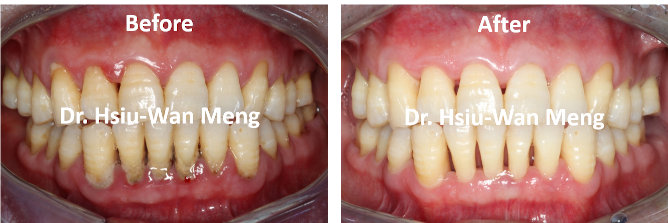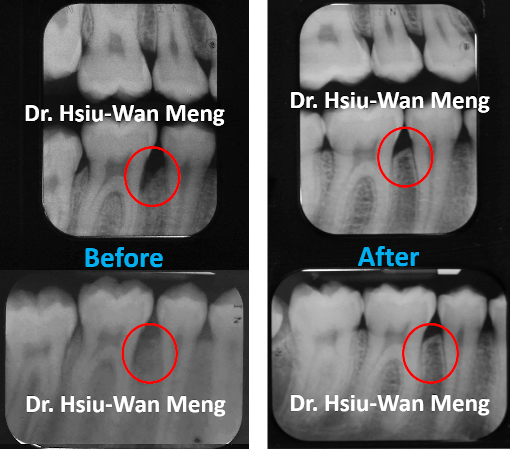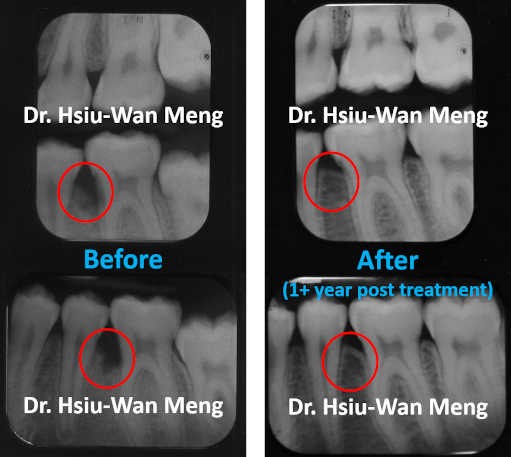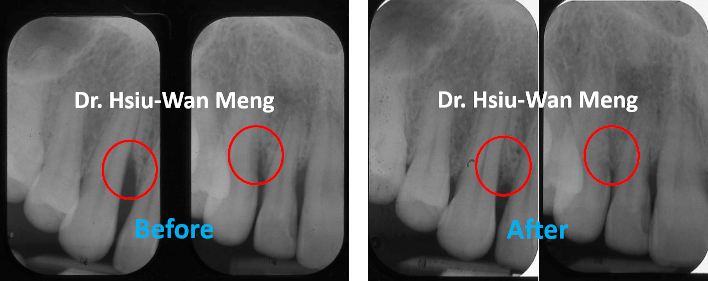Gum Disease Treatment
There are 3 stages in the successful treatment of periodontitis:
- Non-Surgical Therapy
- Oral Hygiene Instruction: The most critical factor for successful treatment of periodontitis is your oral hygiene. No matter how well your dentist/periodontist has cleaned your teeth, if you cannot keep them clean at home, food debris/plaque starts to form right after you eat and will compromise the treatment outcome. Without good home care, professional treatment will not work in the long term! Come to see Dr. Meng and she will show you how to clean your teeth thoroughly and efficiently
- Scaling and Root Planning (SRP, Professional Deep Cleaning): Deep cleaning, also known as Scaling and Root Planing, is a procedure that removes plaque (soft deposit), tartar (hard deposit), and bacteria from below the gum line, where regular tooth brushing and flossing cannot reach. It is typically recommended for patients with gum disease, where the gums have pulled away from the teeth, creating pockets that trap bacteria and debris. During the procedure, the dentist or dental hygienist uses special instruments to clean and smooth the root surfaces of the teeth, helping to promote healing and prevent further damage to the gums and bone. Local anesthesia (numbing) is usually necessary to keep the patient comfortable during the procedure.
- Arestin® (Antibiotics): During deep cleaning, the dentist or dental hygienist may place Arestin® into the periodontal pockets. Arestin® is an antibiotic treatment containing antibiotic minocycline, which belongs to the tetracycline family and prevents the growth of bacteria. It is available in the form of microsphere, which are tiny particles that gradually release minocycline over time, targeting and eliminating the bacteria associated with periodontal disease. Arestin® is commonly used along with deep cleaning to enhance its effectiveness and improve the outcomes for patients with gum diseases. The placement of Arestin® is a simple and minimally invasive procedure. After placement, patients are usually advised to avoid brushing or flossing the treated areas for a certain period.
- Periodontal Re-evaluation (Re-assessment): your dentist/periodontist will make a full periodontal assessment of your gum 4 to 6 weeks after deep cleaning to check the progress of your treatment. If the deep pockets still remain, further treatment options may be suggested, including periodontal surgery.
- Periodontal Surgical Therapy
- Osseous Surgery: Also known as Pocket Reduction Surgery, is a dental procedure that removes and reshapes diseased bone and gum around a tooth affected by gum disease. The goal of the surgery is to reduce periodontal pockets, which are spaces between the teeth and gums where bacteria can accumulate and cause further damage to the bone and surrounding tissue.
- Periodontal Regenerative Surgery: A surgical procedure to restore the damaged or lost structures supporting the teeth due to advanced gum disease. It aims to regenerate the lost bone and tissue to improve the stability and health of the teeth.
- Guided Tissue Regeneration (GTR): This technique involved placing a barrier membrane between the gum tissue and the underlying bone to prevent gum tissue from growing into the bone defect. This allows the cells responsible for bone and tissue regeneration to repopulate the area and promote the growth of new bone and supporting tissue.
- Periodontal Bone Grafting: In cases where there is significant bone loss, bone grafts may be utilized. Bone graft materials are placed into the bone defect to maintain the space and stimulate new bone growth and provide a foundation for supporting the teeth.
- Biological Materials: Advancements in techniques and materials have greatly broadened the treatment options with growth factors and biologic modifiers. These materials can stimulate bone growth at a faster rate and provide more reliable outcomes.
- Periodontal Maintenance (Supportive Periodontal Therapy): Periodontal maintenance is typically recommended for individuals who have been diagnosed with gum disease or have undergone periodontal treatment in the past. Periodontal maintenance every 3 months is essential for preventing the progression of gum diseases and maintain the health of gum and supporting structures of the teeth.
Treatment of Periodontitis
Pocket Reduction Therapy / Osseous Surgery

Periodontal Regeneration / Guided Tissue Regeneration /
Use of Bone Grafts, Membranes, and Biological Materials



